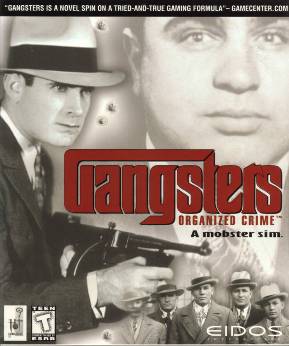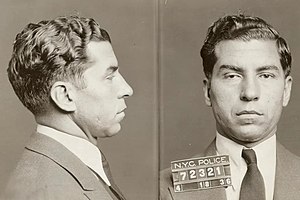 |
| English: The Seal of the United States Federal Bureau of Investigation. For more information, see here. Español: El escudo del Buró Federal de Investigaciones (FBI). Para obtener más información, véase aquí (Inglés). (Photo credit: Wikipedia) |
by Elizabeth Hall
Introduction
Criminology is the study of crime, and criminologists have been developing theories for decades about why people commit crimes (Siegel, 2010). Organized crime is no different, and there are many different theories falling into both Trait Theory and Social StructureTheory categories to explain the actions of others. According to Abadinsky (2009) and the Federal Bureau of Investigation (FBI) (2007), John Gotti “The Teflon Don” encompassed more media attention by himself than any other organized crime figure in history as he ran his organization in the traditional patron-client network style. The bureaucratic-corporate style as used by gangs will also be explored as we look at theory related to gang activity and discuss how the Gangster Disciples fit these theories, comparing and contrasting criminological theory of both styles of organized crime organizations.
 |
| Organized Crime Agency of British Columbia (Photo credit: Wikipedia) |
Social Structure Theories
The theories based on social structure maintain that people commit crimes because of the stratification of the wealth and privileges available to the population (Siegel, 2010). This is particularly true under the capitalism system that the United States utilizes. Although all of the theories in the sociological school of thought hold that the main reason people commit crimes is because they are poor, each one has different ideas on how this condition of poverty plays into criminal behavior (Siegel, 2010). In other words, it means that the socioeconomic conditions of society are the reason we have crime.
 |
| Gangsters: Organized Crime (Photo credit: Wikipedia) |
We will begin by exploring Strain Theory(Siegel, 2010), and just how that ties in to being poor using reason of self-justification of crime. Abadinsky (2009) covers the Theory of Anomie that, began with Emile Durkheim, and developed further by Robert Merton suggests that as we feel anomie or strain based on lack of opportunity to achieve social mobility, people turn to criminal activity to attain the goal. In the United States, Siegel (2008) states that over 37 million people live at or below the poverty level, which translates into the real world terms of dilapidated neighborhoods, poor health care, less desires to achieve means legally, and less opportunity for the people that live in these conditions. Criminal activity is their way of evening the odds according to this theory and organized crime is just how the immigrant population found the road to prosperity in the past. Today this is also a problem in non-immigrant communities as well, as the groups achieve upward social mobility paving the way for others to take their places.
 |
| Al Capone. Mugshot information from Science and Society Picture Gallery: Al Capone (1899-1947), American gangster, 17 June 1931. 'Al Capone sent to prison. This picture shows the Bertillon photographs of Capone made by the US Dept of Justice. His rogue's gallery number is C 28169'. (Photo credit: Wikipedia) |
Next, we will look at what Differential Association Theory implies. This theory popularized by Richard Cloward and Lloyd Ohlin (Siegel, 2008), maintains that people under strain, and in areas of social disorganization will form subcultures. This in turn promotes gang activity to form. These subcultures band together, and in order to reduce the strain turn to criminal activity. The joining inevitably results in a gang mentality, which allows people to adhere to the structure and rules that the gang requires.
Deviant Subculture Theory, introduced as a reason that youth from lower class neighborhoods commit crime in 1955, by Albert Cohen (Siegel, 2008). The theory suggests that youth use their subculture as a way to rebel against societal regulations set by the middle class. What Cohen suggests is that, because they cannot achieve normal standards of success they reach frustration by this status. Once the frustration level has been reached, they use the subculture formed to rebel against societal norms (Siegel, 2008).
Edwin Sutherland, who maintained that anyone could commit criminal acts regardless of class, social standing, or any other factor according to Abadinsky (2009), introduced Differential Opportunity Theory. The main idea is that crime is chosen when the benefits outweigh the costs of the punishment. He holds that this type of behavior is learned from those we associate ourselves with, and that it also comes from conforming to the beliefs, ideals, and regulations set forth by the teacher, or from social engagement with others. This means that according to this theory, crime is a personal choice for everyone (Siegel, 2010).
 |
| Mugshot of Charles Luciano at 1936,Italian-American mobster (Photo credit: Wikipedia) |
Social Control Theory is much like differential opportunity theory in the fact that the main tenet also states that criminal activity is profitable and alluring. Abadinsky (2009) states that, the community decides societal norms, and acceptable behaviors for people to follow. What this theory looks at in criminology is why people would choose not to commit criminal acts. The answer chosen is that morals play a factor. Some people do not commit crimes out of a sense of moral decency, and others conform to the conventional morals of society (Siegel, 2008)
Ethnic Succession Theory is different from the others, as it explains why some groups of people begin in organized crime and then later move into legitimate business ventures. This theory looks at crime as a means to an end, which, once reached, is no longer needed. The Jewish involvement in organized crime in America is a great example of this. Unlike the Italians, the Jewish people value education and religion as the most important goals to pursue. While they began in organized crime in order to achieve upward social mobility, the people willing to commit crimes for easy money fell away once there were legitimate avenues for success. As one group leaves the life of committing crimes for social mobility, another group moves in, as we can see in modern times with the entrance of Asian, Hispanic, and Black criminal activity more prevalent than the Italians, Jews, and Irish of yesteryear (Abadinsky, 2009).
Trait Theory
Psychoanalytical Theory is probably the most well known theory, as most have heard of Sigmund Freud. This theory, which has changed over the years, mainly holds that our unconscious thoughts and feelings at early stages of life denote how we will react to strain and societal pressures according to Abadinsky (2009). This theory deals with normal and abnormal behavior by explaining that it is our balance of our id, ego, and superego, which represent our states of unconscious thoughts, which keep us within normal or abnormal behavior. The main thought is that this happens in our formative years and that we do not have control of this.
 |
| English: Mugshot of famous US organized crime figure. (Photo credit: Wikipedia) |
Behavioral Theory forces the development of criminal activity back on individuals and society by maintaining that we learn criminal behavior from our environmental and social interactions. Operant conditioning is the method that this message is delivered as the theory states that behavior is denoted by the punishment and reward system. The choice to act criminally or not is based on whether the reward is greater than the punishment. This theory holds that if we live in a community that rewards criminal behavior with respect instead of rejecting the behavior there is a lack of positive reinforcement for good behavior, and we learn from those around us that we admire to act criminally (Abadinsky, 2009).
Theory Fitting John Gotti Criminal Development
 |
| English: This FBI-document of 1947 recommends that "one Jack Rubenstein of Chicago" should not be called to testify for the Committee on Unamerican Activities, for he is working for Congressman Richard M. Nixon. According to the Warren Commission, Ruby had no connections with Oswald, Organized Crime or the Government. No wonder the header reads "This is sensitive". (Photo credit: Wikipedia) |
The theory that best explains John Gotti’s involvement in organized crime is Sutherland’s Differential Opportunity Theory. This is because along with his earlier involvement with gangs and the neighborhood he grew up in. During the 1940’s Italian communities still banded together in Italian neighborhoods, where the mafia was already present. The community with the exception of the criminal element was poor, and the opportunities for social advancement not the same as that of other communities, particularly the average white Anglo Saxon community. The social engagement with others included respect in the community for those in the Mafia, as they often provided for the community where society would not. The behavior is learned from the early gang association along with accepting the rules that the mafia set forth and Mr. Gotti excelled in this environment.
Jerome Skolnick and Types of Gangs
Abadinsky (2009), reports that Jerome Skolnick identified two types of gangs in his work on strain theory. These are cultural and entrepreneurial gangs and operate for two different reasons. Cultural gangs strongly identify with the neighborhood that they reside in, and may be involved in drug activity for their monetary gain along with other activity. On the other hand, entrepreneurial gangs operate for the purposes of distributing drugs. Cultural gangs are more identified with the neighborhood, recruiting and maintaining membership based on loyalty to the community. Entrepreneurial gangs have no real loyalty, and operate solely based on continued revenue for the group (Abadinsky, 2009).
Gangster Disciples and Criminological Theory
The criminological theory that best fits the growth of the Gangster Disciples would be Robert Merton’s Theory of Anomie. This theory states that those experiencing strain or anomie because of lack of opportunity to achieve upward social mobility, turn to crime to achieve the goals other obtain with legitimate means. This is particularly true within the African American community, as even with all of the advances of the Civil Rights era, even today there is not necessarily equality between the races. Those who grow up in poor inner city neighborhoods often do not see any way out of the neighborhoods without criminal activity because opportunities to education decent education are not available to all ( Siegel, 2010).
Conclusion
Criminologists study all forms of crime, including organized crime, and develop theories as to why someone might either choose to commit a crime or not. These theories are designed to fit most types of crimes and explain different aspects of organized crime depending on the aspect covered. As we can see, different theories fit different types of criminals such as the difference between John Gotti with the mafia, and gang activity such as that with the Gangster Disciples. Criminologists work to provide these theories so that those who make policy can adjust those policies accordingly to changes in the climate of crime.
References
Abadinsky, H. (2009). Organized crime (9th Ed.). Belmont, CA: Wadsworth, Cengage Learning
ISBN: 0-495-59966-2
ISBN: 0-495-59966-2
Federal Bureau of Investigation (FBI) (2007). A Byte Out of History: John Gotti: How We Made the Charges Stick. Retrieved From: http://www.fbi.gov/news/stories/2007/april/gotti040207
Siegel, L. J. (2008). Criminology: The Core. Third Edition. Belmont, Ca. Cengage Learning ISBN: 13-978-0-495-09477-7
Siegel, L.J. (2010). Criminology: Theories, Patterns, and Typologies. Tenth Edition. Belmont:
Wadsworth Cengage Learning. ISBN: 13-978-0-495-60013-8

















0 comments:
Post a Comment